4-甲基-7-氧香豆素-β-D-葡萄糖苷酸
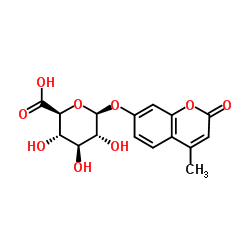
4-甲基-7-氧香豆素-β-D-葡萄糖苷酸结构式

|
常用名 | 4-甲基-7-氧香豆素-β-D-葡萄糖苷酸 | 英文名 | 4-Methylumbelliferylglucuronide |
|---|---|---|---|---|
| CAS号 | 6160-80-1 | 分子量 | 352.293 | |
| 密度 | 1.6±0.1 g/cm3 | 沸点 | 683.1±55.0 °C at 760 mmHg | |
| 分子式 | C16H16O9 | 熔点 | 102 °C | |
| MSDS | 美版 | 闪点 | 255.0±25.0 °C |
4-甲基-7-氧香豆素-β-D-葡萄糖苷酸用途4-甲基伞形花-β-D-葡糖苷酸是一种荧光底物(λex=362 nm,λem=445 nm)。4-甲基伞形花-β-D-葡萄糖醛酸在检测β-葡萄糖醛酸酶活性和大肠杆菌数量方面具有潜在的应用[1][2][3]。 |
| 中文名 | 4-甲基伞型酮-beta-D-葡糖苷酸 |
|---|---|
| 英文名 | 4-Methylumbelliferyl-beta-D-glucuronide |
| 中文别名 | 4-甲基-7-氧香豆素-β-D-葡萄糖苷酸 | 4-甲基-7-乙酰氧基香豆素-β-D-葡萄糖醛酸苷 |
| 英文别名 | 更多 |
| 描述 | 4-甲基伞形花-β-D-葡糖苷酸是一种荧光底物(λex=362 nm,λem=445 nm)。4-甲基伞形花-β-D-葡萄糖醛酸在检测β-葡萄糖醛酸酶活性和大肠杆菌数量方面具有潜在的应用[1][2][3]。 |
|---|---|
| 相关类别 | |
| 体外研究 | 4-甲基伞形花-β-D-葡萄糖醛酸(156µM-5 mM;30分钟)在 37摄氏度下释放 4-甲基伞形酮,用于酶促反应[2]。 4-甲基伞形花-β-D-葡萄糖醛酸(50µg/mL;24小时)在 坦桑尼亚联合共和国培养基中用于检测大肠杆菌数[3]。 |
| 参考文献 |
| 密度 | 1.6±0.1 g/cm3 |
|---|---|
| 沸点 | 683.1±55.0 °C at 760 mmHg |
| 熔点 | 102 °C |
| 分子式 | C16H16O9 |
| 分子量 | 352.293 |
| 闪点 | 255.0±25.0 °C |
| 精确质量 | 352.079437 |
| PSA | 146.66000 |
| LogP | -0.63 |
| 外观性状 | 白色至灰白色粉末 |
| 蒸汽压 | 0.0±2.2 mmHg at 25°C |
| 折射率 | 1.664 |
| 储存条件 | -20℃ 避光,阴凉干燥处,密封保存 |
| 稳定性 | 常温常压下稳定 |
| 水溶解性 | slightly soluble |
| 分子结构 | 1、 摩尔折射率:80.05 2、 摩尔体积(m3/mol):215.8 3、 等张比容(90.2K):654.8 4、 表面张力(dyne/cm):84.7 5、 极化率(10 -24cm 3):31.73 |
| 计算化学 | 1.疏水参数计算参考值(XlogP):无 2.氢键供体数量:4 3.氢键受体数量:9 4.可旋转化学键数量:3 5.互变异构体数量:无 6.拓扑分子极性表面积143 7.重原子数量:25 8.表面电荷:0 9.复杂度:574 10.同位素原子数量:0 11.确定原子立构中心数量:0 12.不确定原子立构中心数量:5 13.确定化学键立构中心数量:0 14.不确定化学键立构中心数量:0 15.共价键单元数量:1 |
| 更多 | 1. 性状:白色粉末 2. 密度(g/mL, 25 ℃ ):未确定 3. 相对蒸汽密度(g/mL,空气=1):未确定 4. 熔点(ºC):102 5. 沸点(ºC,常压):未确定 6. 沸点(ºC,2.67KPa):未确定 7. 折射率:未确定 8. 闪点(º F):未确定 9. 比旋光度(º, C=0.25, 水):-105 10. 自燃点或引燃温度(ºC):未确定 11. 蒸气压(20ºC):未确定 12. 饱和蒸气压(kPa,60ºC):未确定 13. 燃烧热(KJ/mol):未确定 14. 临界温度(ºC):未确定 15. 临界压力(KPa):未确定 16. 油水(辛醇/水)分配系数的对数值:未确定 17. 爆炸上限(%,V/V):未确定 18. 爆炸下限(%,V/V):未确定 19. 溶解性:微溶于水。 |
|
4-甲基-7-氧香豆素-β-D-葡萄糖苷酸毒理学数据: 主要的刺激性影响: 在皮肤上面:可能引起发炎 在眼睛上面:可能引起发炎 致敏作用:没有已知的敏化现象 4-甲基-7-氧香豆素-β-D-葡萄糖苷酸生态学数据: 对水少是稍微危害的,不要让未稀释或大量的产品接触地下水、水道或污水系统 若无政府许可,勿将材料排入周围环境. |
| 个人防护装备 | Eyeshields;Gloves;type N95 (US);type P1 (EN143) respirator filter |
|---|---|
| 危害码 (欧洲) | Xi: Irritant; |
| 风险声明 (欧洲) | R22 |
| 安全声明 (欧洲) | S24/25 |
| 危险品运输编码 | NONH for all modes of transport |
| WGK德国 | 3 |
| 4-甲基-7-氧香豆素-β-D-葡萄糖苷酸上游产品 8 | |
|---|---|
| 4-甲基-7-氧香豆素-β-D-葡萄糖苷酸下游产品 1 | |
|
Development of an enzyme assay for rapid assessment of Escherichia coli in seawaters.
J. Appl. Microbiol. 93(4) , 548-56, (2002) An analytical protocol has been developed and applied for the detection of glucuronidase activity in marine waters as a rapid alternative approach to assess the microbiological quality of seawaters.Th... |
|
|
An alternative approach for enumeration of Escherichia coli in foods.
Int. J. Food Microbiol. 68(3) , 217-23, (2001) An assay to screen Escherichia coli in foods using MUG supplemented lauryl sulfate tryptose (LST) broth instead of tryptone water (TW) medium was evaluated. The results presented in this paper suggest... |
|
|
Serogroup distribution and virulence characteristics of sorbitol-negative Escherichia coli from food and cattle stool.
J. Appl. Microbiol. 108(2) , 658-65, (2010) To (i) study the serogroup distribution and virulence characteristics of non-sorbitol-fermenting Escherichia coli isolates from foods of animal origin and cattle faeces and (ii) re-examine the true so... |
| T66 BOVJ E1 IO- BT6OTJ CQ DQ EQ FVQ &&β-D-Gluco Form |
| (2S,3S,4S,5R,6S)-3,4,5-trihydroxy-6-(4-methyl-2-oxochromen-7-yl)oxyoxane-2-carboxylic acid |
| 4-Methylumbelliferyl β-glucuronide |
| β-D-Glucopyranosiduronic acid, 4-methyl-2-oxo-2H-1-benzopyran-7-yl |
| 2H-1-Benzopyran-2-one, 7-(β-D-glucopyranuronosyloxy)-4-methyl- |
| MFCD00036772 |
| EINECS 228-186-0 |
| 4-Methylumbelliferyl-B-D-glucuronic acid |
| 4-Methylumbelliferone β-D-glucuronide |
| 4-Methylumbelliferylglucuronide |
| 4-Methylumbelliferyl-β-D-glucuronide |
| 4-Methyl-2-oxo-2H-chromen-7-yl β-D-glucopyranosiduronic acid |
| 4'-Methylumbelliferyl-ß-D-glucuronide |
| 4-methyl-2-oxo-2H-1-benzopyran-7-yl β-D-glucopyranosiduronic acid |

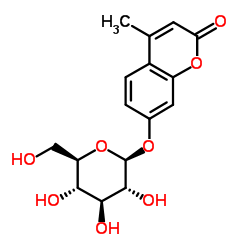 CAS号18997-57-4
CAS号18997-57-4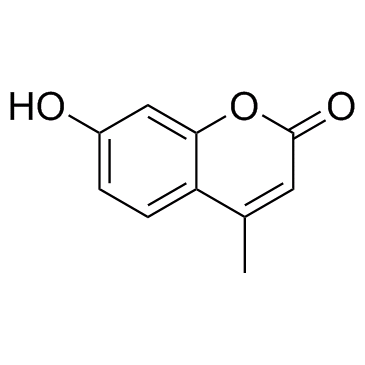 CAS号90-33-5
CAS号90-33-5 CAS号2616-64-0
CAS号2616-64-0 CAS号937018-36-5
CAS号937018-36-5![2H-1-Benzopyran-2-one, 4-methyl-7-[[2,3,4-tri-O-acetyl-6-O-(triphenylmethyl)-β-D-glucopyranosyl]oxy]结构式](https://image.chemsrc.com/caspic/012/937018-35-4.png) CAS号937018-35-4
CAS号937018-35-4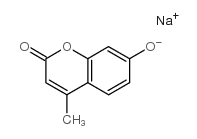 CAS号5980-33-6
CAS号5980-33-6 CAS号101014-65-7
CAS号101014-65-7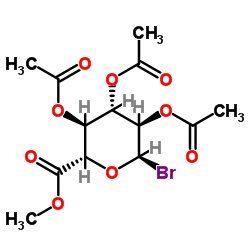 CAS号21085-72-3
CAS号21085-72-3
